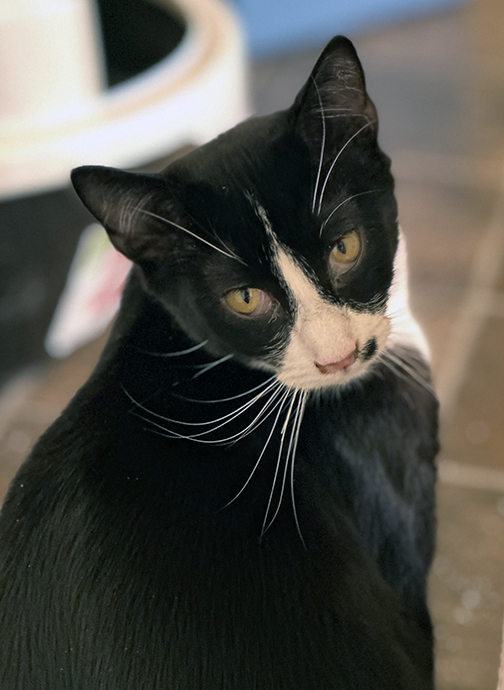
24 Jan Second Chance: Define “Feral Cat” + Highlights
For 30 years, the Animal Resource Center and Shops of Second Chance Humane Society have been serving Ouray, San Miguel, and Montrose Counties. Our adoption hours are from Wednesday to Sunday, 11 a.m. to 5:30 p.m. View our shelter pets and services online atwww.secondchancehumane.org. Connecting Pets, People, and Community While Saving Lives.
View shelter pets and services online: www.adoptmountainpets.org.
Go here for more options from Second Chance.

The term “feral cat” is one of the most misunderstood terms in animal welfare. Some people believe that a feral cat is a wild and dangerous creature which needs to be feared or even shot. Others use the term to describe any homeless outdoor cat. For example, we get calls like this: “There’s a litter of feral kittens under my porch. My kids have been playing with them, and they’re super friendly.”
In that case, the kittens are not feral, but are stray, homeless, abandoned, or community cats.
Observing a cat will help determine if it’s a stray (formerly a pet) or feral.
A stray cat may meow and move like a house cat with its tail up, making eye contact. In contrast, feral cats are usually silent, crouched low to the ground, and will not make eye contact. Strays will be more visible during the daytime hours and may eat near humans. Ferals are typically more nocturnal and will eat food only after humans have retreated. Stray cats may appear dirty and ungroomed. If cornered, a stray cat will try to hide rather than fight. If cornered, a feral cat will hiss, spit, or growl, and is usually not dirty or disheveled. They may have an ear tip if they’ve been through a TNR process.
A feral cat never had contact with people or contact with people diminished over time. Feral cats are generally fearful or wary of people and rarely become lap cats or enjoy living indoors. Successful adoption of feral cats is very rare.
A cat can be feral and not at different points in its life. An outdoor kitten may be born feral and then be socialized and adopted. A pet cat can become homeless and, after living on its own, start to act unsocialized. Feral behavior also varies depending on several factors, including age, generations, contact, and personality.
Age: Kittens born to feral mothers can usually be socialized. After they reach 10-12 weeks old, socialization becomes a more uncertain process. An adult feral cat may require years to socialize if at all.
Generations: The more generations that separate a cat born outdoors from her once-socialized ancestor, the wilder that cat will be. In other words, feral behavior will tend to increase with each successive feral generation.
Contact: Cats who regularly interact with people are more likely to show signs of socialization versus cats who have little or no contact.
Personality: Cats have distinct personalities. Some are naturally friendly and will warm up to people more quickly.
Since feral cats are not adoptable, they should not be taken to animal shelters. Learn about caring for feral cats and cat colonies by visiting Alley Cat Allies website or by reaching out to local groups such as Colorado Kat Coalition.

Tulip
Tulip is a great example of a kitten born to a feral mother. Her mom wouldn’t let anyone near her litter. Our staff and volunteers worked to gain the kittens’ trust, and now Tulip is a sweet and loving girl who still has some shyness at times. She’s lived her whole life in our care and deserves a loving home where she can be part of a family.
AND… To continue the Second Chance Highlights section, we want to share the following:
Making a Difference, One Kibble at a Time
Our Pet Pantry provides free or by-donation pet food and supplies to those in our community who are struggling with homelessness, job loss, or other economic challenges that threaten their ability to keep beloved pets in their homes.
If you know someone who is struggling, we can help.
No appointment needed, and you can stop by during shelter hours: 11 am to 5:30 pm Wednesday to Sunday.
Located in our community building. Staff will assist you.
To check availability of food or supplies, or to make a donation, call (970)626-2273 or email the shelter.
No guarantee of food availability.
Pet Pantry stats for December
We fed 129 cats and 66 dogs, plus two cat colonies, each of about 30 cats.
We served:
15 families in Montrose County
6 families in Ouray County
5 families in San Miguel County
1 family in Delta County
Donations came from:
12/2: Chowdown
12/12: Walmart
12/12: Petco
12/20: Walmart
12/21: Chowdown
12/23: Chowdown
We’re offering:
1/2 Price Dog Adoptions
January 19 through January 31
For all dogs over six months old


Sorry, the comment form is closed at this time.